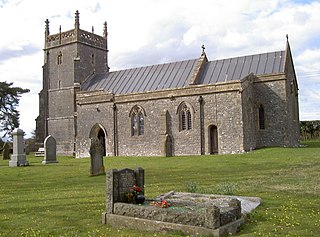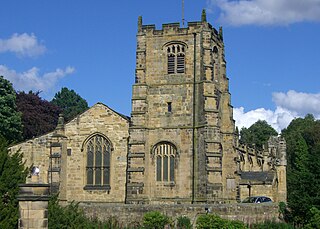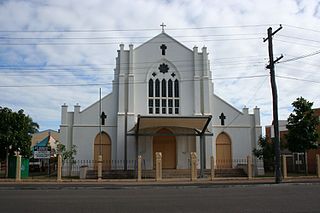
The Church of St Lawrence is situated in the village of Warkworth in Northumberland. It is a grade I listed building within the Diocese of Newcastle and dedicated to St Lawrence of Rome.

The Church of St Lawrence is situated in the village of Warkworth in Northumberland. It is a grade I listed building within the Diocese of Newcastle and dedicated to St Lawrence of Rome.

The present church dates from the 12th century, however a wooden Anglo-Saxon church was mentioned as occupying the site in AD 737, when King Ceolwulf of Northumbria gave Wercewode (as Warkworth was then known) along with St Lawrence's church to the Abbot and monks of Lindisfarne. The wooden church was almost certainly destroyed in the Danish raids of 875 when Halfdan Ragnarsson “pitched his camp by the Tyne and wasted the land cruelly from sea to sea". [1] The church was rebuilt in stone during the 9th and 10th centuries; foundations of this church were discovered in 2008 beneath the present church when an investigative trench was dug. In 1120 Henry I gave St Lawrence's along with the churches at Corbridge, Rothbury and Whittingham to his chaplain Richard de Aurea Valle. Upon his death, all four churches were given to and became part of the newly formed Diocese of Carlisle and would remain so until Newcastle became a separate diocese in 1882.
Building of the church as we see it today began in 1132; it was constructed not only as a holy place but also as a sanctuary for the villagers in dangerous times. It had very substantial walls, with very narrow, high windows to keep out the enemy. On Saturday 13 July 1174, the day of the Battle of Alnwick, Donnchad II, Earl of Fife, commanding a column of the Scottish King William the Lion’s army, entered Warkworth and set fire to the town, killing 300 of the inhabitants who had taken refuge in the church. Around the year 1200 a tower was built at the western end of the church although the belfry and the spire were not added until the 14th century. In the 15th century the south aisle and entrance porch were added; above the porch there is a parvise which is reached by a spiral staircase; prior to 1736 it served as a schoolroom. [2]
In October 1715 Warkworth was the first market town in England to proclaim The Old Pretender as King in the Jacobite rising; his Chaplain read morning prayers in the church on 9 October. On 16 May 1761 John Wesley visited the church to preach a sermon whilst on a visit to nearby Alnwick. In 1860 there were extensive restorations with a new roof being applied, which resulted in the loss of the clerestory windows on the south wall. At the same time plaster was removed from the interior walls and the box pews were replaced by bench pews. [3]
Changes to the church since World War II have seen pews removed from the south aisle and the floor relaid in Caithness stone in 1947. The churchyard has had a new drainage system installed, trees removed and headstones placed around the perimeter walls. The electrical, heating and sound system have been upgraded, while in 1983 the church organ was overhauled.


Movement in the north wall had been known since the 13th century when the tower was erected and buttresses were built to prevent lateral movement in the wall. The wall was built on shallow medieval foundations on alluvial sand and clay close to the tidal River Coquet. Investigations in 2006 showed that the wall was 19 inches out of line and in a dangerous condition; this resulted in the church being placed on English Heritage’s Buildings at Risk Register. In March 2009 work started to secure and stabilise the wall, repair any ensuing damage to the interior of the church and prevent further deterioration. Two new buttresses were built resting on 22-metre piles which went down to the bedrock. The work cost £300,000 with the money coming from grant aid from English Heritage and from a successful fund-raising campaign by the Parochial Church Council. The church was removed from the Buildings at Risk Register on completion of the work. [4] [5]
The church is constructed from squared stone with a graduated Lakeland slate roof to the nave and chancel and a leaded roof to the rest of the church. The present church clock has a slate face with gilded numerals and dates from 1875. It was supplied and fitted by Mr Joyce Whitchurch at a cost of £154.12s. Near the old priests' door into the chancel are three medieval stone coffins which were found under the church floor. [6]
Near the main gate is a distinctive tomb which is the final resting place of Edward Dodsworth of East Chevington, huntsman to King James, who died on 30 May 1630. Dodsworth hunted deer in Scotland with Cuthbert Rayne for King James in the 1590s. [7]
The nave at 27.6 metres (90 feet) is the longest Norman nave in Northumberland; it has a 19th-century scissor-braced roof and was restored in 1860 by John Dobson. The south aisle was built by the Percy family in the 15th century; its east window has the only surviving pieces of medieval glass in the church. The pulpit has five panels each featuring a work of art by Alfred Southwick, including St Lawrence blessing the poor and St Hilda of Whitby. On the right of the main door is the Knight's Tomb in the chantry; it features an image of a cross-legged knight from the 14th century, with a shield bearing the arms of the de Abulyn family of Durham. [8]

St Mary's Church is an Anglican church at the end of a lane to the south of the village of Nether Alderley, Cheshire, England. It dates from the 14th century, with later additions and a major restoration in the late-19th century. The church is recorded in the National Heritage List for England as a designated Grade I listed building.

The Church of St Michael in Milverton, Somerset, England dates from the 13th century, on the site of an even earlier chapel, and has been designated as a Grade I listed building.

The Anglican Church of St Lawrence at Priddy, Somerset, England, dates from the 13th century, with some rebuilding in the 15th century and was restored in 1881–88; it is a Grade I listed building.

Christ Church is a church of the Church in Wales, situated in Rossett, Wrexham County Borough, Wales. It is designated by Cadw as a Grade II listed building. Christ Church is an active Anglican church in the Alyn Mission Area, the archdeaconry of Wrexham and the diocese of St Asaph.

St Peter's Church is the Church of England parish church of the parish of Ardingly in Mid Sussex, one of seven local government districts in the English county of West Sussex. The present building dates from the 14th century and was restored during the Victorian era, but Christian worship on the site has a much longer history. The stone-built, Decorated Gothic-style church, west of the village centre, has been designated a Grade I Listed building.

All Saints' Church is a redundant Anglican church in High Cross Street, Leicester, England. It is recorded in the National Heritage List for England as a designated Grade I listed building, and is under the care of the Churches Conservation Trust.

The Church of St Leonard the Less is an Anglican church in the village of Samlesbury, Lancashire, England, situated close to the banks of the River Ribble. It is an active parish church in the Diocese of Blackburn. It dates predominantly from 1558, with a tower added 1899–1900, and is protected as a Grade I listed building.

St Mary's Church is in Church Avenue, Penwortham, Lancashire, England. It is an active Anglican parish church in the deanery of Leyland, the archdeaconry of Blackburn, and the diocese of Blackburn. The church is recorded in the National Heritage List for England as a designated Grade II* listed building.

St Nicholas' Church, Sturry, is a joint Anglican and Methodist church standing on a bank beside the River Stour, in the village of Sturry, near Canterbury, in East Kent. The Local Ecumenical Partnership enables the congregation to be of mixed denomination - either Methodist or Anglican.

The Church of St Michael and All Angels is a parish church located on Riverside in Felton, Northumberland, England. Built circa 1200, its many alterations and additions have caused it to be almost encased within another church. Some unusual features are that the nave and an aisle appear roofless, as well as a window with geometrical tracery that features an eight-petalled flower patterned central circle cut from a single stone. Dedicated to Saint Michael, it is a Grade I listed building.

St Michael's Church is an Anglican place of worship situated on Bailiffgate in the town of Alnwick in Northumberland, England. The current building dates from the 15th century but a 12th-century Norman chapel stood on the site prior to this; reports of an earlier 8th-century Saxon chapel are unconfirmed. The church is dedicated to St Michael the Archangel, in earlier times it was also dedicated to St Mary as well. It is a Grade I listed building.

St Martin's Church is a Grade I listed Anglican church, dedicated to Martin of Tours, in Ancaster, Lincolnshire, England. The church is 6 miles (10 km) north-east from Grantham, below the southern edge of the Lincoln Cliff, and at the side of High Dyke, part of the old Ermine Street Roman road. St Martin's is in the ecclesiastical parish of Ancaster and Wilsford, in the Deanery of Loveden, and the Diocese of Lincoln.

St Alban's Church, is in Mill Lane, Liscard, Wallasey, Wirral, Merseyside, England. It is an active Roman Catholic church in the diocese of Shrewsbury. The church is recorded in the National Heritage List for England as a designated Grade II listed building.

St Patrick's Church is a heritage-listed Roman Catholic church at 58 Morgan Street, Fortitude Valley, City of Brisbane, Queensland, Australia. It was designed by Andrea Giovanni Stombuco and built from 1880 to 1882 by John Arthur Manis O'Keefe. It was added to the Queensland Heritage Register on 21 October 1992.

St Lawrence Parish Church is a Grade II* listed building in the village of Hunworth in Norfolk, England. The church is dedicated to Saint Lawrence who was martyred in 258 AD.

St Joseph's Church is a heritage-listed Roman Catholic church at Fryer Street, North Ward, City of Townsville, Queensland, Australia. It was designed by Charles Dalton Lynch and Walter Hunt and built from 1920 to 1921 by Joseph Rooney. It is also known as St Joseph on The Strand. It was added to the Queensland Heritage Register on 26 November 1999.

St Peter and Paul's Old Cathedral is a heritage-listed former Catholic cathedral and now parish church at 42 Verner Street, Goulburn, Goulburn Mulwaree Council, New South Wales, Australia. It was designed by Andrea Stombuco and Charles Spadacini and built from 1871 to 1890 by C. J. O'Brien and Wilkie Bros. It is also known as St. Peter and Paul's Former Cathedral and St Peter and Paul's Catholic Cathedral; Saints Peter and Paul's Catholic Cathedral. It was added to the New South Wales State Heritage Register on 20 April 2009.

St Anne's Church is a heritage-listed Roman Catholic church located at 60 Blair Street, North Bondi, Waverley Municipality, New South Wales, Australia. The church was designed by Joseph Fowell and Kenneth McConnel, and built from 1934 to 1964 by R. M. Bowcock. It is also known as St. Anne's Church and St Anne's Shrine. The property is owned by the Sisters of Mercy and it was added to the New South Wales State Heritage Register on 26 May 2006.

St Margaret's Church is a 13th-century Church of England church in the village of Whaddon, Gloucestershire, England. It has been a grade II* listed building since 10 January 1955. The church tower is a dominant feature within the surrounding flat area.

St Peter's is one of seven churches in the parish of Upper Tas Valley All Saints in south Norfolk, ten miles south of Norwich, UK. The full name is St Peter's and St Paul's, commonly known as St Peter's, and this was formerly the parish church for Forncett St Peter. It is an active place of worship and a nationally significant Grade I listed building. Its Anglo-Saxon round tower, built about 1000 AD, is considered one of the best in the country. There are other Anglo-Saxon features. Much of the main building is of later, mainly 14th and 15th century, date. Significant features are: the 1485 Drake tomb, a unique ancient staircase in the tower, carved pew ends, fine ledger slabs in the chancel and nave, good examples of Victorian coloured glass windows, and the ring of six bells. There is a comprehensive modern guide to the church. There is a connection with William Wordsworth: his sister, Dorothy, lived at the rectory from 1788 until 1794 with her uncle, the rector, William Cookson.